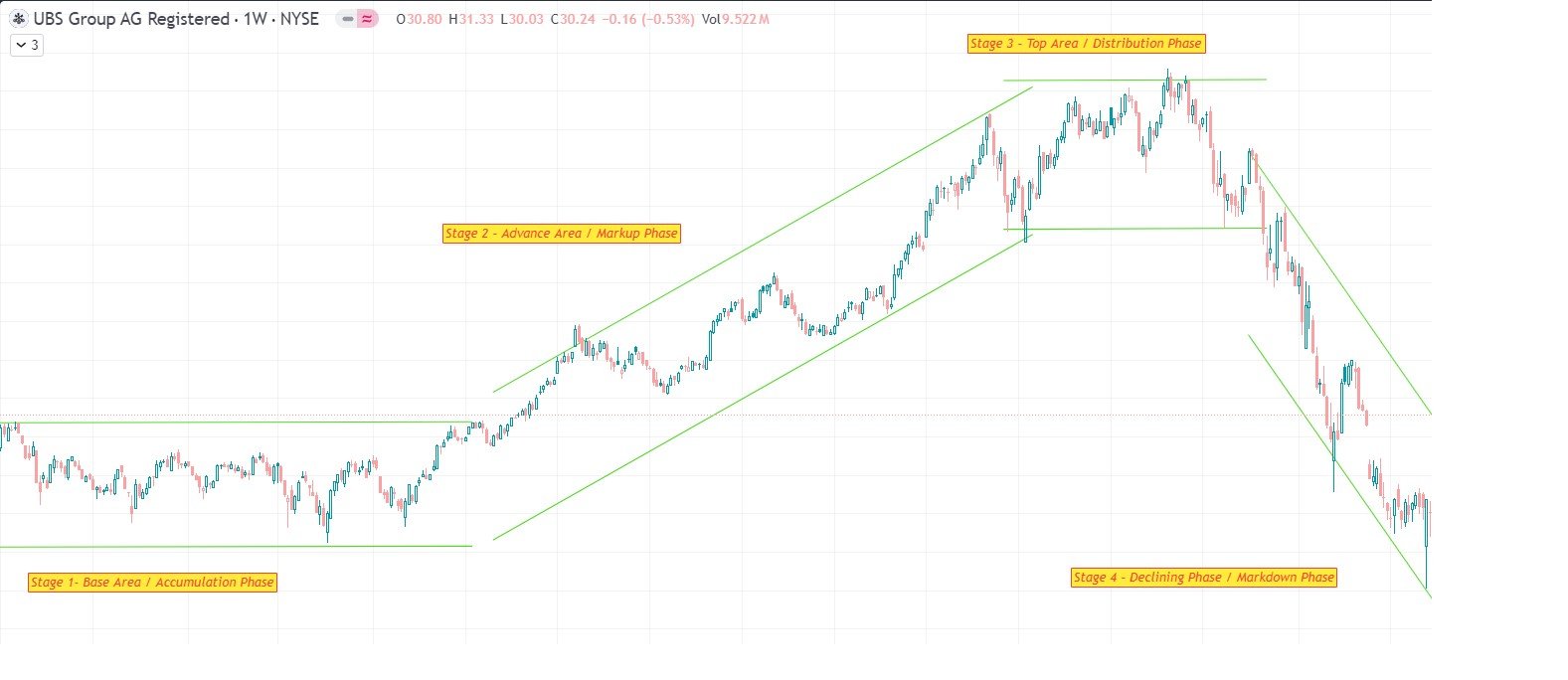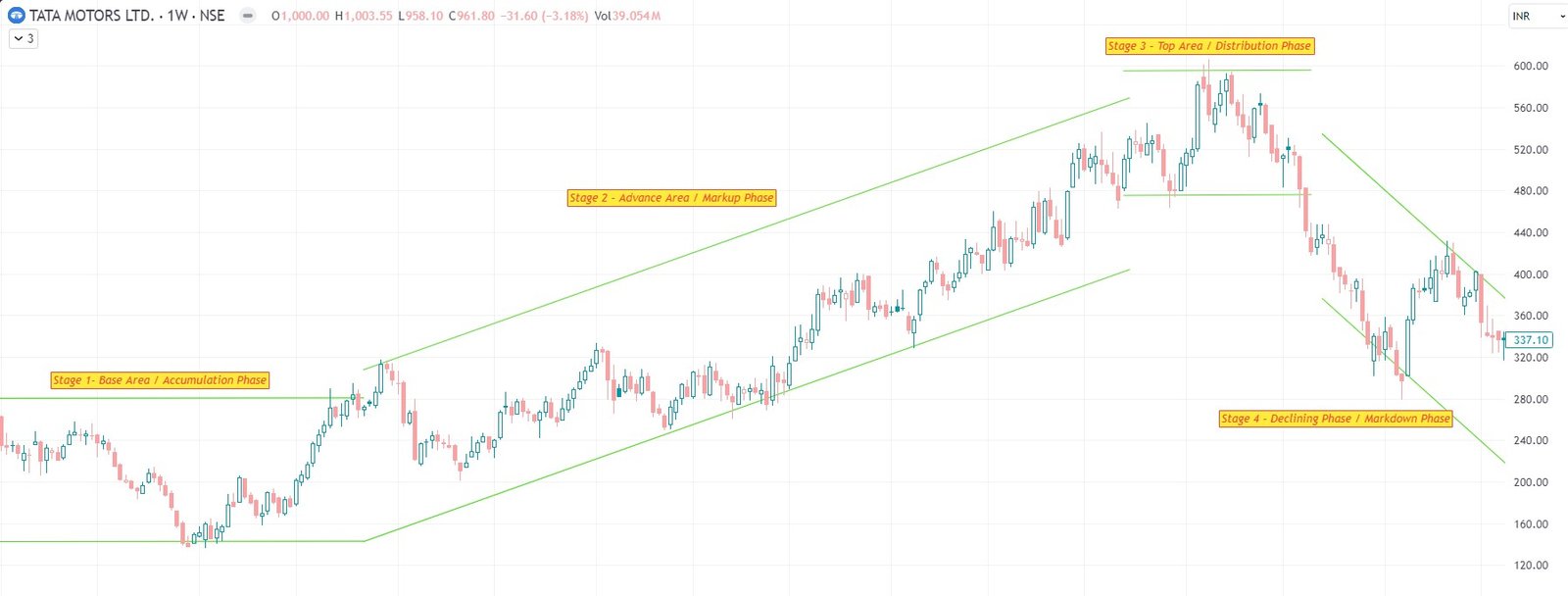Introduction:
Every stock is going through its life cycle. It is cyclical in nature. Each state has a different perspective and different behaviour of sentiment. It is from the Introduction stage to the mature stage. In the fundamental analysis, we are known as the Introduction stage, Growth stage, Maturity stage and Decline stage. In technical analysis, there are four stages are exist in the stock life cycle. Stage 1, Stage 2, Stage 3 and Stage 4. Stage 1 is called Basing Area, Stage 2 is called Advance Area, Stage 3 is called Top Area and Stage 4 is called Declining Phase. In some cases it is called Accumulation as Stage 1, Markup phase as Stage 2, Distribution as Stage 3 and Markdown as Stage 4. Normally all the phases continue from several weeks to several months. Let’s discuss all the phases in detail below.
Stage 1 – Base Area / Accumulation Phase
In this Phase, investors are starting accumulating stock. As investors are accumulating stocks, this is called the Accumulation phase. Also, this phase is called Base Area because, in this phase, long bases are being formed for many months. This phase can be formed in two situations, either it is listed recently or the stock was in a downside moment for a longer period. If the stock was downside for a longer period and trading sideways, it means downside momentum has lost its ground. The sideways trend shows sellers and buyers are equilibrium, which means buyers are showing interest in this stock. In previous cases when the stock was on the downside, sellers were stronger. This means buyers are accumulating this stock and not allowing stocks to move down further. We can say that, in this phase Supply and Demand are equal.
Stage 2 – Advance Area / Markup Phase
In this phase, stock comes out from its Base area or accumulation phase. In this phase, a breakout happens from its Resistance Zone. In this phase, the stock starts moving upside. In the advanced phase, buyers take control of the stock and sellers are moving out of the market. In this phase, Demand is more compared with supply, which is the reason it is moving higher. In the advanced phase normally it is seen that stock fundamentals are starting to improve. In terms of earnings, Business expansion, Profit margin and PE starts improving in this phase. In this phase, buying opportunity comes on every dip. In the later stage of phase fear of missing out takes place. In this phase price moves higher supported by positive news, strong earnings and favourable economic conditions. In this phase stocks often break down from the previous resistance zone. The price movement depends upon the overall market condition, economic factors, and broader market conditions. If all the factors are positive, it will multiply the speed of stock price in an upward direction. In this phase media’s is attention comes at the later stage of the phase.
Stage 3 – Top Area / Distribution Phase
This is the area at are top of the trend. In this again buyers are sellers are equal and the market is sideways. It means sellers have entered this market and taking control of Buyers. In this area again supply and demand are equal. It is a similar situation or mirror image of stage 1. In this phase normally it is seen that the Fundamentals of the stock are at pick of performance. In this phase story of the stock is exciting and good news is spreading everywhere in the news. This means its earnings are at pick, stock split and higher PE etc. In this phase, smart money or institutional investors start selling their stocks. This is the early sign of market reversal. In this phase market sentiment shifts from optimistic to cautious or neutral. Stock price appears to be overvalued for Price to Earning ratio (P/E Ratio), Price to book value (P/B Value), and price-to-sales ratio (P/S ratio). In some cases, earnings show slightly missed expectations. In stage 4, sometimes false breakouts appear in the resistance zone.
Stage 4 – Declining Phase / Markdown Phase
It is the last cycle of the stock life cycle. This last phase is a mirror image of Stage 2, where sellers are in control of the stock. In this phase, Demand is more than supply. In this phase, the stock price is moving down. In this stage stock breakdown from the support zone. In this phase, investor sentiment is moving from bullish to bearish. In this phase prices consistently falls. The declining phase depends on the fundamentals of stocks like company performance, market condition and economic influence. In this phase, fear dominates the stock and reduces confidence in the stock’s prospects. In terms of fundamentals like falling revenue, falling profit margin, increased debt and operational challenges come out of the stocks. Normally in stage 4, the volatility of the sock increases. If the broader market is down, the decline phase will be more fast. Also, stage 4 depends upon the macro and micro economic factors as well as industry-specific news. If the environment is negative, it will be a more fast declining phase and vice versa
Conclusion:
Based on the stock stages, investors can make a strategic decision aligned with financial goals. Each stage has unique opportunities and challenges. In stage 1, a higher risk-reward scenario appeals to higher risk. In Stage 2, risk-reward is good and balanced. In stage 3, the stock provides steady returns and lower volatility. Investors shift focus from high growth to stable growth. In stage 3, investor reassess their positions and consider the existing or reallocation of their investment. So we can conclude that, when we are investing or taking a position in the stock, it is essential to analyze the overall market condition as well as the stock stage.


FAQ:
- What is Stage 1 & Stage 2 of the stock market?
A: Stage 1 is the Accumulation Phase, where smart money or investors are taking entry into stocks. Stage 2 is the Markup phase, where stock prices come out of the Resistance zone and move up and make a higher high.
- What happens when a stock drops out of Stage 4?
A: When the stock drops out of Stage 4, again it goes to Stage 1 (Accumulation Phase)
- When is a good time to buy a stock?
A: The ideal time to take entry in stocks is early to Stage 2 when the stock comes out of Stage 1.
- How to identify the stages of stock?
A: Identification of stock stages can done by Technical Analysis of stocks with some common characteristics of stocks.
Next: How to identify the Stock Stage for trading and investment (with Practical Example).
Very interesting topic, thanks for posting.Expand blog
Hi fantastic website! Does runhning a blog such as this
take a large amount of work? I’ve vitually no knowledge of programming but I
had been hoping to start my own bloog soon. Anyway, should you have any ideas or tips ffor new blog owners
please share. I know this is off topic however I simply
haad to ask. Kudos! http://Boyarka-Inform.com/
Happy to dive into discussions, share thoughts, and learn something new as I go.
I like hearing diverse viewpoints and adding to the conversation when possible. Interested in hearing different experiences and connecting with others.
There’s my site:https://automisto24.com.ua/
Happy to explore discussions, share experiences, and gain fresh perspectives as I go.
I’m interested in understanding different opinions and sharing my input when it’s helpful. Happy to hear fresh thoughts and meeting like-minded people.
Here’s my site:https://automisto24.com.ua/
I pay a quick visi evrry day some web pages andd information sites to read posts, but this webpage provides feature based writing. http://Boyarka-inform.com/
Hey very nice website!! Man .. Excellent .. Amazing .. I will bookmark your website and take the feeds also?I am happy to find a lot of useful information here in the post, we need develop more strategies in this regard, thanks for sharing. . . . . .